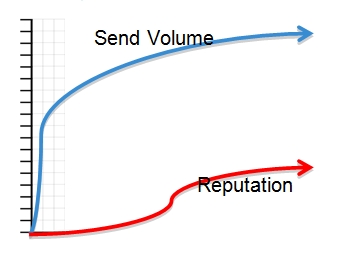Warmup Duration
Learn the ideal warmup duration for IPs and domains. Gradually increase send volume over 30 days to build reputation and ensure high email deliverability.
How Many Days Should a Warmup Plan Run?
The duration of a warmup plan is critical for building a strong sender reputation. Selecting the right number of warmup days ensures a gradual and consistent increase in email sending volume, avoiding issues like spam flags or IP blacklisting.
Poor Warmup Strategy
Description: Sending a large volume of emails too quickly causes reputation to drop, as mailbox providers see it as suspicious. This can lead to spam filtering or IP blacklisting.
Lesson: Avoid sending high volumes immediately, as it harms sender reputation and deliverability.

Ideal Warmup Strategy
Description: Gradually increasing send volume over time helps reputation grow steadily. This approach builds trust with mailbox providers, ensuring better inbox placement.
Lesson: Slow, consistent growth in send volume is key to building a strong and reliable sender reputation.

Ideal Warmup Duration
Minimum Warmup Period: At least 15 days for low-volume campaigns or smaller email lists.
Recommended Warmup Period: 30 days is ideal for medium to high-volume campaigns, allowing sufficient time to build trust with mailbox providers.
Extended Warmup Period: 60 days or more for new domains or IPs that need extra time to establish a reliable sender reputation.
Factors Affecting Warmup Duration
Email Volume:
For small campaigns, 15–20 days may be sufficient.
Large-scale campaigns require 30+ days for gradual scaling.
Domain/IP Reputation:
New domains or recently registered IPs benefit from longer warmup plans.
Established domains/IPs with no history of spam require a shorter warmup period.
Recipient Engagement:
High engagement rates (e.g., opens and clicks) may reduce the need for an extended warmup period.
Low engagement or high bounce rates may require extending the warmup period.
Mailing Frequency:
Daily senders should aim for a 30-day warmup.
Weekly or occasional senders may extend to 60+ days for consistency.
Why Stick to the Recommended Warmup Days?
Mailbox Provider Trust: Gradual volume increases signal authentic and trustworthy behavior.
Avoids Reputation Damage: Sudden spikes in volume can trigger spam filters or IP blacklisting.
Ensures Deliverability: Proper warmup ensures emails consistently land in the inbox, not spam folders.
Was this helpful?